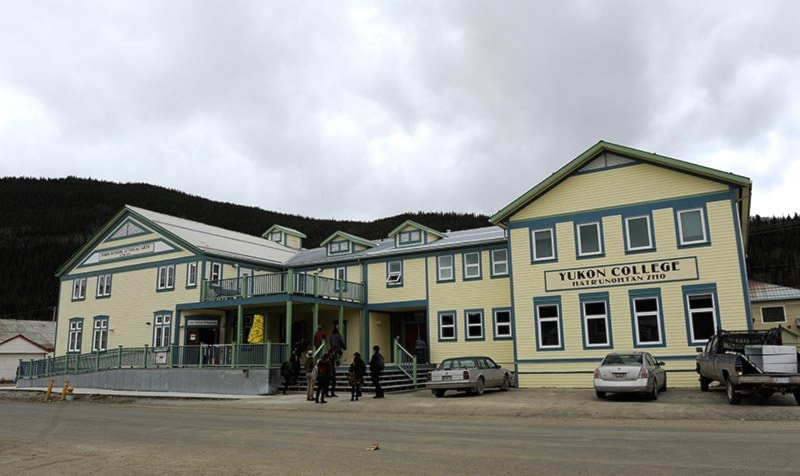There may be a light at the end of the tunnel for some of those seeking rental housing in Dawson City.
On Aug. 9, city council approved a demolition permit for the old Cassiar building at the corner of Queen Street and Second Avenue.
Work can now begin on a new apartment complex planned by the Chief Isaac Group of Companies, the business arm of the Tr’ondek Hwech’in First Nation.
“That was kind of the last hurdle,” said architect Jack Kobayashi.
The complex is to include 14 units — nine one-bedroom affordable housing units subsidized by Yukon Housing, four two-bedroom market rental units and a commercial unit opening onto the street. There will be no parking at the site, but parking will be available at another property two blocks away.
Kobayashi said he hopes the demolition of the Cassiar building will happen in September, and foundation work for the new building will begin in October. He said that’s the ideal month to do earth work in Dawson, because the weather is cold enough that the permafrost won’t melt, but not so cold that the ground is completely frozen.
He hopes the building will be complete by October 2017.
Housing, particularly the lack of rental housing, is a perennial problem in Dawson.
Construction costs are so high that it’s difficult for developers to make any money on new rental projects, and Kobayashi said this Chief Isaac development is no exception.
“We’ve run the numbers. The economic returns are terrible. No one in their right mind would ever do this project, unless they were only thinking of the common good,” he said. “It won’t lose money, but it’s not an attractive financial investment.”
The rental housing shortage is a problem that Curtis Collins, director of Dawson’s Yukon School of Visual Arts, knows all too well.
The school was established in 2007, and is now entering its 10th year. It was designed to host cohorts of 15 students each year, but only nine students completed the program last year, and 10 the year before that. Collins said the lack of housing has a lot to do with the low enrolment.
He said that students may be interested in the one-year program, but when they start looking online for housing, they come up empty. Telling them they’ll eventually find something if they just come to Dawson and start asking around is a hard sell, he explained.
“You can imagine that if it’s difficult to convince a young person of that, their parents pose an even greater dilemma,” he said. “Moving to Dawson is the equivalent of moving from the Earth to the moon.”
Chris Healey, a board member of the Dawson City Arts Society, agreed that housing is a major barrier when it comes to attracting students to SOVA.
“This is just like a bleak, horrible housing landscape in a dark, distant land that as far as they know is populated by polar bears and is dark all the time,” he said.
Healey’s son attended SOVA last year, and he also struggled to find housing. Healey said he “went through the circuit of just horrible substandard places to live” for a while before finding a decent home.
“Places with cracks between the windows and walls … places with no plumbing, places with very dodgy heating, mould, structurally the place doesn’t look like it’s really standing up very well,” he said.
Healey said the housing crunch is harmful for the community, because it drives people away who otherwise might stay. He said all levels of government need to get on board to solve the problem.
Both he and Collins were critical of the Yukon government’s decision to tear down the old McDonald Lodge, which Collins said “would have been absolutely perfect” for SOVA students.
The government has said that renovating the building was not financially viable.
Even Chief Isaac’s new building may do little to help the SOVA students. Lynn Hutton, Chief Isaac’s president and CEO, said the complex is intended to “free up the housing crisis already in Dawson, as opposed to provide housing for students.”
But she added that SOVA and student housing are “on (her) radar.”
Meanwhile, the Klondike Development Organization has been working on a rental housing project of its own for several years.
Project manager Mark Wickham said in an email that the organization is currently “in final stages of securing financing for construction,” and hopes to begin construction in October and have people moving in next summer.
The plan is for six one-bedroom units rented at $900/month and two two-bedroom units at $1,275/month. The project will target working people with household incomes between $35,000 and $55,000, and not exceeding $76,000. It will be not-for-profit, but residents will not receive financial assistance.
Wickham said the idea is to “bridge the gap between Yukon Housing social housing and home ownership.”
While the new project could free up spaces elsewhere for students, it’s also not intended as student housing.
“Given the cost of construction, developing new-build individual apartments at affordable rates to a typical student budget is not feasible,” he said.
Healey said there are many empty, neglected buildings in Dawson, including a couple of hotels downtown. But so far, it doesn’t seem that anyone has a viable plan to turn them into housing that students could afford.
For SOVA’s 10th year, Collins is expecting a group of 10 to 12 students. But he can’t say for sure what the final number will be until they find places to live.
“I guess it’s frustrating for me, because I have this conversation on a regular basis,” he said. “And I don’t see any immediate solutions on the horizon.”
Contact Maura Forrest at
maura.forrest@yukon-news.com
